“It’s an American road trip story like Kerouac, Ginnsberg or Easy Rider” Ryan O’Sullivan talks Void Trip and going from the indies to Image
 Ryan O’Sullivan and Plaid Klaus’ Turncoat fired it’s way onto our Top 10 Indie Comics Of The Year for 2016 with it’s hilarious tale of a super villain hitman. So when we discovered Ryan and Plaid were uniting again for a new book at Image, then we knew we were in for another twisted treat! We catch up with Ryan to find out more about this psychedelic space adventure and what it’s like going from the indies to Image!
Ryan O’Sullivan and Plaid Klaus’ Turncoat fired it’s way onto our Top 10 Indie Comics Of The Year for 2016 with it’s hilarious tale of a super villain hitman. So when we discovered Ryan and Plaid were uniting again for a new book at Image, then we knew we were in for another twisted treat! We catch up with Ryan to find out more about this psychedelic space adventure and what it’s like going from the indies to Image!
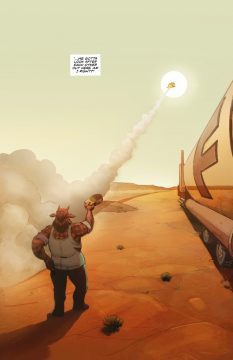
Void Trip sees you reunite with Turncoat artist Plaid Klaus, is it great being back working with him or did you do it straight after finishing Turncoat and so didn’t have time to miss each other?
Ryan O’Sullivan: Luckily, I’ve not had any time to miss Klaus as we jumped straight into Void Trip after we finished the final chapter of Turncoat. I’ve found that whenever I get towards the end of one story, the next one starts forming. It’s one part wanting to do something new, and one part what you wish you’d done differently in the story you’re currently wrapping up.
Plus, Klaus and I chat a lot. We’re always throwing story ideas, or just ideas in general at each other. Every now and again one will stick and start forming into a comic book concept. I’m lucky to be working with someone who brings out the best in me. He’s very much a creative collaborator from the beginning of everything we do and I’m lucky to be working with him.
With it being published by Image it feels like you’ve really stepped up a level – especially with the design – how did you get involved with Image, did you pitch to them, or did they hear about you through Turncoat? And how’s the process been compared to self publishing/webcomics?
ROS: Thank you, that’s kind of you to say. Full credit to Klaus for all of that design/aesthetic stuff. We collaborate on what we want the book to look like, but the final visuals are all him. I like to think we’ve improved from Turncoat. I’m very proud of that book, but it was our first book.
As for Image. I have no idea if they’d heard of Turncoat prior to us talking to them. (And I’m not sure it would have made much difference if they had.) We pitched Void Trip to their publisher Eric Stephenson at Thought Bubble last year and he really dug it. From there it was just a case of making the comic and emailing him regular updates. Easy! (It’s not easy. It is life-consuming and the source of nearly all of my neurosis.)
In terms of working with Image, it has been a dream. Their process is very hands-off. They’ve got a big team of very talented and very helpful people, but a lot is left up to the creators in terms of reaching out to other creators/retailers/press outlets. And for good reason – to work in creator owned comics you pretty much have to be your own business. And while Image do support you in pretty any way you ask them to, the success of your comic is in your own hands, completely. Having that level of freedom, at the biggest creator-owned publisher in the direct market, is unbelievably empowering man. I’m really enjoying working with them.
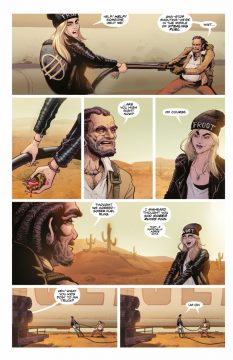
We love the fact that that your characters are unashamed bad guys – and were in Turncoat too – is that going to be a feature of your work do you think? And what draws you to write about evil people (or are they just misguided?)
ROS: I’ve always found characters with a certain amount of moral ambiguity more fun to write than straight up good guys or bad guys. A lot of pop culture entertainment, comics especially, tends to create very “us vs them” stories. This makes it hard to write about genuine characters. I enjoy writing about the range of the human experience. For example, I like my books to be politically neutral. It takes no talent to write a didactic polemic against XYZ politician/religion/etc. I’d much rather critique human existence, and the suffering inherent in it, as a whole. That’s much more relatable and interesting in my mind. I think this is why I tend towards neutral characters, who have a degree of moral ambiguity, rather than over overt good or bad ones.
Of course when you talk about “moral ambiguity” most people tend to think of a Good Guy who murders Bad People. I don’t mean that at all. When I talk of morally ambiguous characters, I simply mean they’re not paragons of virtue nor are they evil bastards. They’re like me and you on our best and on our worst days. They’re human.
You’ve done an incredible effort in world building and creating new characters, do you design that part of a story first or does it build around the story you want to tell? Which bits of the story are your favourites or gave you a buzz creating them or seeing Plaid draw them?
ROS: I’m not a big fan of worldbuilding. John Harrison had some pretty great thoughts on why:
“Worldbuilding is dull. Worldbuilding literalises the urge to invent. Worldbuilding gives an unnecessary permission for acts of writing (indeed, for acts of reading). Worldbuilding numbs the reader’s ability to fulfil their part of the bargain, because it believes that it has to do everything around here if anything is going to get done.
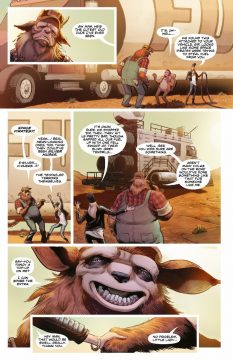
Above all, worldbuilding is not technically necessary. It is the great clomping foot of nerdism. It is the attempt to exhaustively survey a place that isn’t there. A good writer would never try to do that, even with a place that is there. It isn’t possible, & if it was the results wouldn’t be readable: they would constitute not a book but the biggest library ever built, a hallowed place of dedication & lifelong study. This gives us a clue to the psychological type of the worldbuilder & the worldbuilder’s victim, & makes us very afraid.”
I like to keep things as minimal as possible. Bare bones plot. Low character count. Invent the locations as the story needs them. The scripting stage is focused on dialogue and art direction, not plot/world creation. In fact, by the time I get to the scripting stages, the entire comic series will be plotted out meticulously. However, with that said, occasionally one character or place will emerge as more relevant to the latter stages of the comic than we realised, so their role will grow in the writing. I’m a big fan of the Ascended Extra character trope. I think the best worldbuilding, once you’ve got a strong understanding of your setting and plot, comes naturally. Charles Dickens was famous for it. He released most of his novels as serialised fiction and, every now and then, he’d invent a new character that he thought he might need later on in the story. More often than not, he would, and whenever he used them, his readers always credited him for a gift of foresight he didn’t really have. There’s a good reason comic writers like Warren Ellis and Neil Gaiman swear by Charles Dickens. He’s every bit our progenitor.
Also, whilst we’re on the subject of worldbuilding. I’d highly recommend J.G. Keeley’s three-part article on the nature of worldbuilding in fiction. Keeley is one of my favourite comic critics, and I’ve learned as much from him as I have any of the aforementioned authors:
Part 1: https://starsbeetlesandfools.blogspot.co.uk/2012/10/worldbuilding-and-origin-of-fandom-part.html
Part 2: http://starsbeetlesandfools.blogspot.co.uk/2012/12/worldbuilding-and-origin-of-fandom-part.html
Part 3: http://starsbeetlesandfools.blogspot.co.uk/2012/12/worldbuilding-part-iii-what-fiction.html
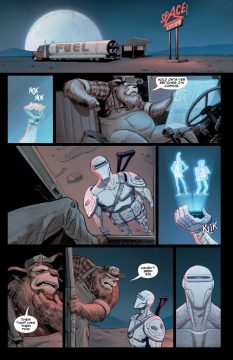
The Froot section adds a weird psychedelic angle to the story is that going to be a regular part of the series or just a one off for this issue?
ROS: Void Trip is an American road trip story, along the lines of the beat generation poets and authors like Kerouc or Ginnsberg, or 1960s counter-cultural movies like Easy Rider. This psychedelic approach influences the characters, and sometimes the storytelling, but I wouldn’t say Void Trip itself is Psychedelic. Or maybe it is and Klaus and I are too…excited all the time to notice. That said, Froot isn’t just a throwaway gag, it plays a very important part to the series as a whole, and is deeply embedded in the entire story.
How long is the series planning to run for?
ROS: Void Trip is five issues long, with a trade paperback collection to follow it next year. We haven’t planned out a second arc/trade, but you never know. If people go bonkers for it we could always extend. I’m really enjoying writing in this universe, and I know which characters I’d focus on, given another chance to continue playing here. But then there’s a part of me which thinks you shouldn’t extend a story when you know how it ends. Hmm. Let’s go with maybe.
How has working on licensed titles for Titan Comics helped develop you as a writer? Does it help you working in different genres as well?
ROS: The licensed work I’ve done for Titan, such as the Warhammer 40,000 and The Evil Within titles, has really helped develop me as a writer. Working on licensed properties that you don’t own across , when your stories have to be approved by other people, teaches you a lot of discipline. You have to write in a certain tone, yet not lose what makes you, you. You have to learn to write in a lot of different genres, but not loose sight of the appeal of the specific franchise you’re writing for. In fact, the big difference is that when I’m writing something like Turncoat or Void Trip, I’m doing it because I want to write that story, not because I have a certain audience in mind. But with my licensed work, it’s always with a specific audience in mind. It’s commercial writing, no doubt about it. The trick is to find the small areas within the limitations set to you by the licensor that you can be creative within. There is nothing worse than a comic writer, high off amphetamines and a desperate need to be the next Grant Morrison, subverting or over-writing a videogame comic. You’re writing for fans of an existing property. They’re reading it because of the license, not because of you. It’s humbling, and it’s testing, and it will force you to grow as a writer.
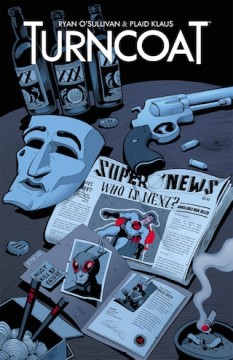 And finally, will we be seeing any more from the Turncoat characters any time soon? Or is that series done and dusted?
And finally, will we be seeing any more from the Turncoat characters any time soon? Or is that series done and dusted?
ROS: While I’m still very proud of the book, Turncoat was the place where I really learned the nuts and bolts of how to write comics and was also where Klaus and I cemented our creative relationship. All of my early influences were vomited up into that graphic novel and they’re not influences that have followed me into Void Trip or any of my other work. I do occasionally miss Duke, Scarebear, Galadorin, and the huge cast of characters we created there. Never say never, we might go back to it.
But, if I’m honest I’m more interested in future books. I’ve seen too many comic creators in indie comics make sequels for their first comic, with each sequel being less popular than the last. I get why they do it, they fall in love with the concepts they’ve come up with, or they have a following of readers they want to keep feeding the same stuff to. But that’s not for me. I want to make new stuff. It’s the only way to build a successful career as a comic writer and, more importantly, it’s the only way to ensure that you are expressing yourself to the fullest. If I’m telling the same stories in five years then I haven’t grown as a writer. And to not grow as a writer is to die.
You can purchase Void Trip #1 from the Image Comics Digital Store or ComiXology



October 9, 2025 @ 2:45 am
For the reason that the admin of this site is working, no uncertainty very quickly it will be renowned, due to its quality contents. Go live with star sports live cricket — IPL and international cricket. quick start and stable playback. extended highlights, stats and tables, interviews. smooth HD streams.